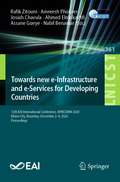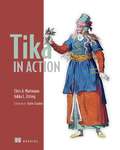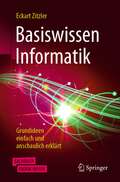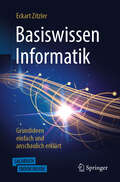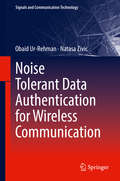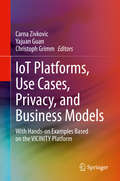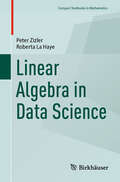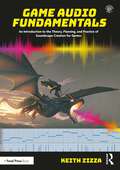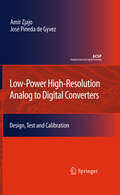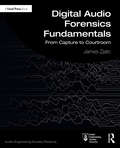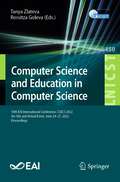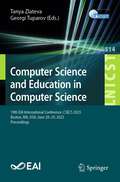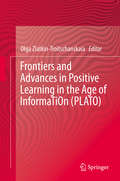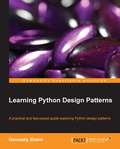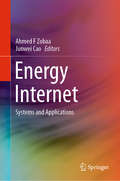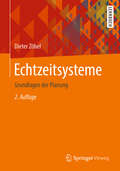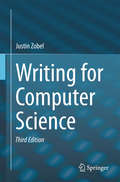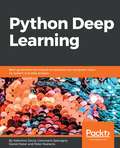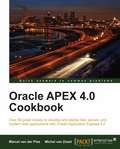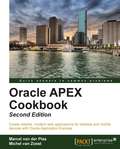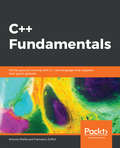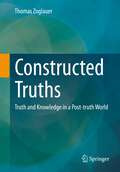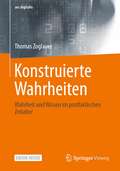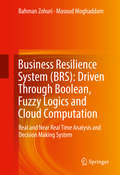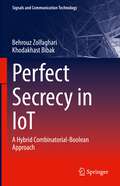- Table View
- List View
Towards new e-Infrastructure and e-Services for Developing Countries: 12th EAI International Conference, AFRICOMM 2020, Ebène City, Mauritius, December 2-4, 2020, Proceedings (Lecture Notes of the Institute for Computer Sciences, Social Informatics and Telecommunications Engineering #361)
by Rafik Zitouni Amreesh Phokeer Josiah Chavula Ahmed Elmokashfi Assane Gueye Nabil BenamarThis book constitutes the thoroughly refereed proceedings of the 12th International Conference on e-Infrastructure and e-Services for Developing Countries, AFRICOMM 2020, held in Ebène City, Mauritius, in December 2020. Due to COVID-19 pandemic the conference was held virtually. The 20 full papers were carefully selected from 90 submissions. The papers are organized in four thematic sections on dynamic spectrum access and mesh networks; wireless sensing and 5G networks; software-defined networking; Internet of Things; e-services and big data; DNS resilience and performance.
Tika in Action
by Jukka L. Zitting Chris MattmannSummaryTika in Action is a hands-on guide to content mining with Apache Tika. The book's many examples and case studies offer real-world experience from domains ranging from search engines to digital asset management and scientific data processing.About the TechnologyTika is an Apache toolkit that has built into it everything you and your app need to know about file formats. Using Tika, your applications can discover and extract content from digital documents in almost any format, including exotic ones.About this BookTika in Action is the ultimate guide to content mining using Apache Tika. You'll learn how to pull usable information from otherwise inaccessible sources, including internet media and file archives. This example-rich book teaches you to build and extend applications based on real-world experience with search engines, digital asset management, and scientific data processing. In addition to architectural overviews, you'll find detailed chapters on features like metadata extraction, automatic language detection, and custom parser development.This book is written for developers who are new to both Scala and Lift and covers just enough Scala to get you started. Purchase of the print book comes with an offer of a free PDF, ePub, and Kindle eBook from Manning. Also available is all code from the book. What's InsideCrack MS Word, PDF, HTML, and ZIPIntegrate with search engines, CMS, and other data sourcesLearn through experimentationMany examplesThis book requires no previous knowledge of Tika or text mining techniques. It assumes a working knowledge of Java.==========================================Table of ContentsPART 1 GETTING STARTEDThe case for the digital Babel fishGetting started with TikaThe information landscapePART 2 TIKA IN DETAILDocument type detectionContent extractionUnderstanding metadataLanguage detectionWhat's in a file?PART 3 INTEGRATION AND ADVANCED USEThe big pictureTika and the Lucene search stackExtending TikaPART 4 CASE STUDIESPowering NASA science data systemsContent management with Apache JackrabbitCurating cancer research data with TikaThe classic search engine example
Basiswissen Informatik: Grundideen einfach und anschaulich erklärt
by Eckart ZitzlerDieses reich bebilderte Sachbuch bietet Ihnen einen einfachen, aber fundierten Einstieg in das Gebiet der Informatik und erklärt Schritt für Schritt, wie Computer und Internet funktionieren. In 18 Kapiteln werden die Schlüsselbegriffe, die der Computertechnologie zugrunde liegen, in überschaubaren Portionen erläutert. Dabei wird bewusst auf technische Details, Formeln und komplizierte Definitionen verzichtet, der Fokus liegt auf dem Verstehen der Ideen. Es geht um digital und analog, die innere Funktionsweise und den Aufbau von Computern, um Codierung, Programmiersprachen, Algorithmen und Datenstrukturen, um die Prinzipien und die Nutzung des Internets sowie um Künstliche Intelligenz, Verschlüsselung und Sicherheit. Das Buch ist in drei Teile untergliedert und führt vom Einsteigen über das Vertiefen zum Durchdringen. Es richtet sich an alle, die ein Basiswissen in Informatik erwerben und hinter die Kulissen der digitalen Welt schauen wollen. Damit die Computerwissenschaft kein Buch mit sieben Siegeln bleibt. Die vorliegende 2. Auflage ist ergänzt um einen Ausblick zu den Themen Deep Learning, Quantum Computing, Blockchain sowie Virtual/Augmented Reality.
Basiswissen Informatik - Grundideen einfach und anschaulich erklärt
by Eckart ZitzlerDieses reich bebilderte Sachbuch bietet Ihnen einen einfachen, aber fundierten Einstieg in das Gebiet der Informatik und erklärt Schritt für Schritt, wie Computer und Internet funktionieren. In 18 Kapiteln werden die Schlüsselbegriffe, die der Computertechnologie zugrunde liegen, in überschaubaren Portionen erläutert. Dabei wird bewusst auf technische Details, Formeln und komplizierte Definitionen verzichtet, der Fokus liegt auf dem Verstehen der Ideen. Es geht um digital und analog, die innere Funktionsweise und den Aufbau von Computern, um Codierung, Programmiersprachen, Algorithmen und Datenstrukturen, um die Prinzipien und die Nutzung des Internets sowie um Künstliche Intelligenz, Verschlüsselung und Sicherheit. Das Buch ist in drei Teile untergliedert und führt vom Einsteigen über das Vertiefen zum Durchdringen. Es richtet sich an alle, die ein Basiswissen in Informatik erwerben und hinter die Kulissen der digitalen Welt schauen wollen. Damit die Computerwissenschaft kein Buch mit sieben Siegeln bleibt.
Noise Tolerant Data Authentication for Wireless Communication (Signals And Communication Technology)
by Natasa Zivic Obaid Ur-RehmanThis book provides insight into the challenges in providing data authentication over wireless communication channels. The authors posit that established standard authentication mechanisms – for wired devices – are not sufficient to authenticate data, such as voice, images, and video over wireless channels. The authors propose new mechanisms based on the so-called soft authentication algorithms, which tolerate some legitimate modifications in the data that they protect. The authors explain that the goal of these algorithms is that they are tolerant to changes in the content but are still able to identify the forgeries. The authors go on to describe how an additional advantage of the soft authentication algorithms is the ability to identify the locations of the modifications and correct them if possible. The authors show how to achieve this by protecting the data features with the help of error correcting codes. The correction methods are typically based on watermarking, as the authors discuss in the book.Provides a discussion of data (particularly image) authentication methods in the presence of noise experienced in wireless communication;Presents a new class of soft authentication methods, instead of the standard hard authentication methods, used to tolerate minor changes in image data;Features authentication methods based on the usage of authentication tags as well as digital watermarks.
IoT Platforms, Use Cases, Privacy, and Business Models: With Hands-on Examples Based on the VICINITY Platform
by Carna Zivkovic Yajuan Guan Christoph GrimmThis book provides a comprehensive and consistent introduction to the Internet of Things. Hot topics, including the European privacy legislation GDPR, and homomorphic encryption are explained. For each topic, the reader gets a theoretical introduction and an overview, backed by programming examples. For demonstration, the authors use the IoT platform VICINITY, which is open-source, free, and offers leading standards for privacy. Presents readers with a coherent single-source introduction into the IoT;Introduces selected, hot-topics of IoT, including GDPR (European legislation on data protection), and homomorphic encryption;Provides coding examples for most topics that allow the reader to kick-start his own IoT applications, smart services, etc.
Linear Algebra in Data Science (Compact Textbooks in Mathematics)
by Peter Zizler Roberta La HayeThis textbook explores applications of linear algebra in data science at an introductory level, showing readers how the two are deeply connected. The authors accomplish this by offering exercises that escalate in complexity, many of which incorporate MATLAB. Practice projects appear as well for students to better understand the real-world applications of the material covered in a standard linear algebra course. Some topics covered include singular value decomposition, convolution, frequency filtering, and neural networks. Linear Algebra in Data Science is suitable as a supplement to a standard linear algebra course.
Game Audio Fundamentals: An Introduction to the Theory, Planning, and Practice of Soundscape Creation for Games
by Keith ZizzaGame Audio Fundamentals takes the reader on a journey through game audio design: from analog and digital audio basics to the art and execution of sound effects, soundtracks, and voice production, as well as learning how to make sense of a truly effective soundscape. Presuming no pre-existing knowledge, this accessible guide is accompanied by online resources – including practical examples and incremental DAW exercises – and presents the theory and practice of game audio in detail, and in a format anyone can understand. This is essential reading for any aspiring game audio designer, as well as students and professionals from a range of backgrounds, including music, audio engineering, and game design.
Low-Power High-Resolution Analog to Digital Converters
by Amir Zjajo José Pineda de GyvezWith the fast advancement of CMOS fabrication technology, more and more signal-processing functions are implemented in the digital domain for a lower cost, lower power consumption, higher yield, and higher re-configurability. This has recently generated a great demand for low-power, low-voltage A/D converters that can be realized in a mainstream deep-submicron CMOS technology. However, the discrepancies between lithography wavelengths and circuit feature sizes are increasing. Lower power supply voltages significantly reduce noise margins and increase variations in process, device and design parameters. Consequently, it is steadily more difficult to control the fabrication process precisely enough to maintain uniformity. The inherent randomness of materials used in fabrication at nanoscopic scales means that performance will be increasingly variable, not only from die-to-die but also within each individual die. Parametric variability will be compounded by degradation in nanoscale integrated circuits resulting in instability of parameters over time, eventually leading to the development of faults. Process variation cannot be solved by improving manufacturing tolerances; variability must be reduced by new device technology or managed by design in order for scaling to continue. Similarly, within-die performance variation also imposes new challenges for test methods. In an attempt to address these issues, Low-Power High-Resolution Analog-to-Digital Converters specifically focus on: i) improving the power efficiency for the high-speed, and low spurious spectral A/D conversion performance by exploring the potential of low-voltage analog design and calibration techniques, respectively, and ii) development of circuit techniques and algorithms to enhance testing and debugging potential to detect errors dynamically, to isolate and confine faults, and to recover errors continuously. The feasibility of the described methods has been verified by measurements from the silicon prototypes fabricated in standard 180nm, 90nm and 65nm CMOS technology.
Digital Audio Forensics Fundamentals: From Capture to Courtroom (Audio Engineering Society Presents)
by James ZjalicDigital Audio Forensics Fundamentals offers an accessible introduction to both the theory and practical skills behind this emerging field of forensic science. Beginning with an overview of the history of the discipline, the reader is guided through forensic principles and key audio concepts, before being introduced to practical areas such as audio enhancement, audio authentication, and the presentation of reports. Covering all aspects of audio forensics from the capture to the courtroom, this book is pivotal reading for beginners entering the field, as well as experienced professionals looking to develop their knowledge of the practice.
Computer Science and Education in Computer Science: 18th EAI International Conference, CSECS 2022, On-Site and Virtual Event, June 24-27, 2022, Proceedings (Lecture Notes of the Institute for Computer Sciences, Social Informatics and Telecommunications Engineering #450)
by Tanya Zlateva Rossitza GolevaThis book constitutes the refereed post-conference proceedings of the 18th EAI International Conference on Computer Science and Education in Computer Science, CSECS 2022, held in June 2022 in Sofia, Bulgaria. Due to COVID-19 pandemic the conference was held On-Site and virtually.The 15 full papers and 9 short papers were carefully reviewed and selected from 53 submissions. The papers present are grouped into 2 tracks, i.e., computer science implementations and education in computer science. CSECS conference presents research in software engineering and information systems design, cryptography, the theoretical foundation of the algorithms, and implementation of machine learning and big data technologies. Another important topic of the conference is the education in computer science which includes the introduction and evaluation of computing programs, curricula, and online courses, to syllabus, laboratories, teaching, and pedagogy aspects. The technical and education topics evolved multiple existing and emerging technologies, solutions, and services for design and training providing a heterogeneous approach towards delivering Software 4.0 and Education 4.0 to a broad range of citizens and societies.
Computer Science and Education in Computer Science: 19th EAI International Conference, CSECS 2023, Boston, MA, USA, June 28–29, 2023, Proceedings (Lecture Notes of the Institute for Computer Sciences, Social Informatics and Telecommunications Engineering #514)
by Tanya Zlateva Georgi TuparovThis book constitutes the refereed post-conference proceedings of the 19th International Conference on Computer Science and Education in Computer Science, CSECS 2023, held in June 2023 in Boston, MA, USA.The 23 full papers and 9 short papers were carefully reviewed and selected from 88 submissions. The papers cover many systems technologies, applications, and services as well as solutions. Multiple topics have been addressed including the theory of computation, models of computation, computational complexity and cryptography, logic, design, and analysis of algorithms, network architectures, performance evaluation, network services, software engineering, software creation, and management, applied computing, machine learning, and education.
Frontiers and Advances in Positive Learning in the Age of InformaTiOn (PLATO)
by Olga Zlatkin-TroitschanskaiaResearch on students’ media use outside of education is just slowly taking off. Influences of information and communication technologies (ICT) on human information processing are widely assumed and particularly effects of dis- and misinformation are a current threat to democracies. Today, higher education competes with a very diverse (online) media landscape and domain-specific content from sources of varying quality, ranging from high-quality videographed lectures by top-level university lecturers, popular-scientific video talks, collaborative wikis, anonymous forum comments or blog posts to YouTube remixes of discipline factoids and unverified twitter feeds. Self-organizing learners need more knowledge, skills, and awareness on how to critically evaluate quality and select trustworthy sources, how to process information, and what cognitive, affective, attitudinal, behavioral, and neurological effects it can have on them in the long term. The PLATO program takes on the ambitious goal of uniting strands of research from various disciplines to address these questions through fundamental analyses of human information processing when learning with the Internet. This innovative interdisciplinary approach includes elements of ICT innovations and risks, learning analytics and large-scale computational modelling aimed to provide us with a better understanding of how to effectively and autonomously acquire reliable knowledge in the Information Age, how to design ICTs, and shape social and human-machine interactions for successful learning. This volume will be of interest to researchers in the fields of educational sciences, educational measurement and applied branches of the involved disciplines, including linguistics, mathematics, media studies, sociology of knowledge, philosophy of mind, business, ethics, and educational technology.
Learning Python Design Patterns
by Gennadiy ZlobinThis book takes a tutorial-based and user-friendly approach to covering Python design patterns. Its concise presentation means that in a short space of time, you will get a good introduction to various design patterns.If you are an intermediate level Python user, this book is for you. Prior knowledge of Python programming is essential. Some knowledge of UML is also required to understand the UML diagrams which are used to describe some design patterns.
Energy Internet: Systems and Applications
by Ahmed F Zobaa Junwei CaoThis textbook is the first of its kind to comprehensively describe the energy Internet, a vast network that efficiently supplies electricity to anyone anywhere and is an internet based wide area network for information and energy fusion. The chapters are organized into five parts: Architecture and Design, Energy Switching and Routing, Information and Communication, Energy Management Systems and Energy Market and Trading, and capture the spectrum of this exponential transformation, while also presenting the plethora of open problems that this transformation poses for researchers from mixed academic backgrounds. The scope includes key technologies on distributed energy sources, microgrids, energy storage, solar and wind energy, power grid, smart grid, power quality, power electronics, data centers, distributed computing and networking, cloud computing and big data, and software-defined networking. The book presents the basic principles of energy internet and emphasizes the current research trends in the field of energy Internet at an advanced level. It includes instructor materials, case-studies, and worked examples throughout. This is an ideal resource for students in advanced graduate-level courses and special topics in energy, information and control systems, and is a useful tool for utility engineers who seek an intuitive understanding of the emerging applications of energy Internet.
Echtzeitsysteme: Grundlagen der Planung
by Dieter ZöbelOhne unmittelbar in Erscheinung zu treten, steuern Echtzeitsysteme heute Produktionsanlagen, assistieren beim Autofahren oder sichern die Qualität der Sprachübertragung in weltweiten Netzen. Sie greifen in technische Prozesse ein, um sie zum richtigen Zeitpunkt zu den richtigen Aktionen zu bewegen. Das Lehrbuch beschreibt Echtzeitsysteme aus der Sicht der Informatik mit dem Schwerpunkt Real-time Scheduling. Es richtet sich an Studierende der Informatik und Wirtschaftsinformatik. Zahlreiche Aufgaben mit Lösungen helfen, den Stoff zu vertiefen.
Writing for Computer Science
by Justin ZobelAll researchers need to write or speak about their work, and to have research that is worth presenting. Based on the author's decades of experience as a researcher and advisor, this third edition provides detailed guidance on writing and presentations and a comprehensive introduction to research methods, the how-to of being a successful scientist. Topics include: · Development of ideas into research questions; · How to find, read, evaluate and referee other research; · Design and evaluation of experiments and appropriate use of statistics; · Ethics, the principles of science and examples of science gone wrong. Much of the book is a step-by-step guide to effective communication, with advice on: · Writing style and editing; · Figures, graphs and tables; · Mathematics and algorithms; · Literature reviews and referees' reports; · Structuring of arguments and results into papers and theses; · Writing of other professional documents; · Presentation of talks and posters. Written in an accessible style and including handy checklists and exercises, Writing for Computer Science is not only an introduction to the doing and describing of research, but is a valuable reference for working scientists in the computing and mathematical sciences.
Python Deep Learning
by Valentino Zocca Gianmario Spacagna Daniel Slater Peter RoelantsTake your machine learning skills to the next level by mastering Deep Learning concepts and algorithms using Python. About This Book Explore and create intelligent systems using cutting-edge deep learning techniques Implement deep learning algorithms and work with revolutionary libraries in Python Get real-world examples and easy-to-follow tutorials on Theano, TensorFlow, H2O and more Who This Book Is For This book is for Data Science practitioners as well as aspirants who have a basic foundational understanding of Machine Learning concepts and some programming experience with Python. A mathematical background with a conceptual understanding of calculus and statistics is also desired. What You Will Learn Get a practical deep dive into deep learning algorithms Explore deep learning further with Theano, Caffe, Keras, and TensorFlow Learn about two of the most powerful techniques at the core of many practical deep learning implementations: Auto-Encoders and Restricted Boltzmann Machines Dive into Deep Belief Nets and Deep Neural Networks Discover more deep learning algorithms with Dropout and Convolutional Neural Networks Get to know device strategies so you can use deep learning algorithms and libraries in the real world In Detail With an increasing interest in AI around the world, deep learning has attracted a great deal of public attention. Every day, deep learning algorithms are used broadly across different industries. The book will give you all the practical information available on the subject, including the best practices, using real-world use cases. You will learn to recognize and extract information to increase predictive accuracy and optimize results. Starting with a quick recap of important machine learning concepts, the book will delve straight into deep learning principles using Sci-kit learn. Moving ahead, you will learn to use the latest open source libraries such as Theano, Keras, Google's TensorFlow, and H20. Use this guide to uncover the difficulties of pattern recognition, scaling data with greater accuracy and discussing deep learning algorithms and techniques. Whether you want to dive deeper into Deep Learning, or want to investigate how to get more out of this powerful technology, you'll find everything inside. Style and approach Python Machine Learning by example follows practical hands on approach. It walks you through the key elements of Python and its powerful machine learning libraries with the help of real world projects.
Oracle APEX 4.0 Cookbook
by Michel Van ZoestAs a cookbook, this book enables you to create APEX web applications and to implement features with immediately usable recipes that unleash the powerful functionality of Oracle APEX 4.0. Each recipe is presented as a separate, standalone entity and reading of other prior recipes is not required. It can be seen as a reference and a practical guide to APEX development. This book is aimed both at developers new to the APEX environment and at intermediate developers. More advanced developers will also gain from the information at hand. If you are new to APEX you will find recipes to start development. If you are an experienced user you will find ways to work smarter and more easily with APEX and enhance your applications. A little knowledge of PL/SQL, HTML and JavaScript is assumed.
Oracle APEX Cookbook - Second Edition
by Michel Van Zoest Marcel Van PlasAs a Cookbook, this book enables you to create APEX web applications and to implement features with immediately usable recipes that unleash the powerful functionality of Oracle APEX 4.2. Each recipe is presented as a separate, standalone entity and the reading of other, prior recipes is not required.It can be seen as a reference and a practical guide to APEX development.This book is aimed both at developers new to the APEX environment and at intermediate developers. More advanced developers will also gain from the information at hand.If you are new to APEX you will find recipes to start development and if you are an experienced user you will find ways to improve your productivity and efficiency and make the most of APEX to enhance your applications.A little knowledge of PL/SQL, HTML and JavaScript is assumed.
C++ Fundamentals: Hit the ground running with C++, the language that supports tech giants globally
by Francesco ZoffoliThis book is for professional developers who want to learn a new, powerful language; and students who are ready to enter into the industry. Software developers familiar with older C++ standards, who want to update their knowledge to the modern paradigms of C++11, C++14 and C++17, are also welcome. This book is aimed at anyone passionate about programming, and who is ready to grasp a powerful yet complex language.
Constructed Truths: Truth and Knowledge in a Post-truth World
by Thomas ZoglauerIn a world in which more and more fake news is being spread, it is becoming increasingly difficult to distinguish truth from lies, knowledge from opinion. Disinformation campaigns are not only perceived as a political problem, but the fake news debate is also about fundamental philosophical questions: What is truth? How can we recognize it? Is there such a thing as objective facts or is everything socially constructed? This book explains how echo chambers and alternative worldviews emerge, it blames post-factual thinking for the current truth crisis, and it shows how we can escape the threat of truth relativism.
Konstruierte Wahrheiten: Wahrheit und Wissen im postfaktischen Zeitalter (ars digitalis)
by Thomas ZoglauerIn einer Welt, in der immer mehr Fake News verbreitet werden, wird es zunehmend schwieriger, Wahrheit und Lüge, Wissen und Meinung auseinanderzuhalten. Desinformationskampagnen werden nicht nur als ein politisches Problem wahrgenommen, vielmehr geht es in der Fake-News-Debatte auch um fundamentale philosophische Fragen: Was ist Wahrheit? Wie können wir sie erkennen? Gibt es so etwas wie objektive Fakten oder ist alles sozial konstruiert? Dieses Buch erklärt, wie Echokammern und alternative Weltbilder entstehen, es macht das postfaktische Denken für die gegenwärtige Wahrheitskrise verantwortlich und zeigt, wie wir einem drohenden Wahrheitsrelativismus entgehen können.
Business Resilience System (BRS) (BRS): Real and Near Real Time Analysis and Decision Making System
by Bahman Zohuri Masoud MoghaddamThis book provides a technical approach to a Business Resilience System with its Risk Atom and Processing Data Point based on fuzzy logic and cloud computation in real time. Its purpose and objectives define a clear set of expectations for Organizations and Enterprises so their network system and supply chain are totally resilient and protected against cyber-attacks, manmade threats, and natural disasters. These enterprises include financial, organizational, homeland security, and supply chain operations with multi-point manufacturing across the world. Market shares and marketing advantages are expected to result from the implementation of the system. The collected information and defined objectives form the basis to monitor and analyze the data through cloud computation, and will guarantee the success of their survivability's against any unexpected threats. This book will be useful for advanced undergraduate and graduate students in the field of computer engineering, engineers that work for manufacturing companies, business analysts in retail and e-Commerce, and those working in the defense industry, Information Security, and Information Technology.
Perfect Secrecy in IoT: A Hybrid Combinatorial-Boolean Approach (Signals and Communication Technology)
by Behrouz Zolfaghari Khodakhast BibakPerfectly-secure cryptography is a branch of information-theoretic cryptography. A perfectly-secure cryptosystem guarantees that the malicious third party cannot guess anything regarding the plain text or the key, even in the case of full access to the cipher text. Despite this advantage, there are only a few real-world implementations of perfect secrecy due to some well-known limitations. Any simple, straightforward modeling can pave the way for further advancements in the implementation, especially in environments with time and resource constraints such as IoT. This book takes one step towards this goal via presenting a hybrid combinatorial-Boolean model for perfectly-secure cryptography in IoT. In this book, we first present an introduction to information-theoretic cryptography as well as perfect secrecy and its real-world implementations. Then we take a systematic approach to highlight information-theoretic cryptography as a convergence point for existing trends in research on cryptography in IoT. Then we investigate combinatorial and Boolean cryptography and show how they are seen almost everywhere in the ecosystem and the life cycle of information-theoretic IoT cryptography. We finally model perfect secrecy in IoT using Boolean functions, and map the Boolean functions to simple, well-studied combinatorial designs like Latin squares. This book is organized in two parts. The first part studie s information-theoretic cryptography and the promise it holds for cryptography in IoT. The second part separately discusses combinatorial and Boolean cryptography, and then presents the hybrid combinatorial-Boolean model for perfect secrecy in IoT.
